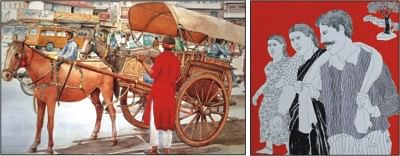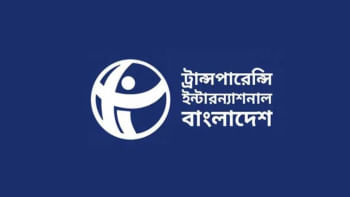Beyond boundaries

Paintings by G.N. Qazi (Pakistan), left, and Laxman Aelay (India).
“Transcending Borders II”, an exhibition of contemporary art from India, Pakistan and Bangladesh, was held from February 7 to 8 at Radisson Water Garden Hotel in the city. The exhibition was inaugurated by Secretary, Ministry of Foreign Affairs, Mohamed Mijarul Quayes. Guest of honour was Muhammad A. Ali, Chairman Brac Bank Limited.
The unique art exhibition came to the city courtesy Ishi Jami (Pakistani-Canadian) and Ritu Jain (from India) and showcased the works of highly renowned artists from the sub-continent. The aim was to capture the spirit, cultural complexity and charm of South Asia, while celebrating the harmony and friendship between India, Pakistan and Bangladesh. The two-day event featured works of high distinction and diverse styles, genres and cultural themes.
The history of contemporary art in Bangladesh began in 1947, at the time of partition. Zainul Abedin, (well-known for his sketches of the Bengal Famine of 1943) and some of his fellow artists who were educated in West Bengal, opted to settle down in East Bengal. They set up the first art school in the newly formed state. This institute trained a generation of new artists whose work reflected the changing times. Painters of the 1050s took to abstraction. The creation of Bangladesh as a separate entity further influenced the art of the nation. Artists of the '70s started using a more figurative language. Bangladeshi art received a tremendous impetus when the government of Bangladesh organised The First Asian Art Biennial in 1981.
India's art heritage is a remarkable document of the country's changing face through the ages. Art, paintings and sculpture have been significant part of its daily life since prehistoric times. The enormous variety in style, technique, media and themes is a pointer to the richness of Indian art and its evolution. Indian art has retained a unique character in spite of assimilating in its fold myriad other influences that have come its way. Over the past century it has shown a diverse range of artistic responses to reality.
Pakistani artists have a keen understanding and appreciation of their country's rich cultural heritage as well as an awareness of international trends. They use a vibrant assortment of techniques and textures to portray their emotions. Their art reflects images of an evolving nation, faced with the challenges of transition. Many of these talented artists are bringing forth the harsh realities of life that are often suppressed. The art schools have helped students realise their potential and this has led to a lot of progress in the field of contemporary Pak art in the last 20 years. The artists of Lahore are conscious of its Mughal heritage, whereas the work of Karachi artists is eclectic.
This exhibition was an effort to transcend borders and celebrate the richness in the culture of the three nations.
The 11 Bangladeshi artists whose works were on display: Late Quamrul Hasan (Master), Farida Zaman, Rafiqun Nabi, Shahid Kabir, Nasreen Begum, Kalidas Karmakar, Jamal Ahmed, Rokeya Sultana, Kanak Champa, Mithu and Nazia Andaleeb Preema.
Featured Indian artists were: Laxman Aelay, Vijay Belgave, Deepa Vedpathak, Raosaheb Gurav, Arvind Kolapkar, Shantkumar Hattarki, Sujata Achrekar and Jyoti Hattarki.
Also on display were works by Pakistani artists: Late Eqbal Mehdi (Master), Mashkoor, Abrar Ahmed, Hajra Mansur, Farrukh Shahab, M.A. Bukhari (contemporary calligraphy), S. Rind, Abid Madad, Amjad Butt (contemporary calligraphy), Nahid Raza, G.N. Qazi and Safdar Qureshi (Miniaturist).
Sponsors of the event were BRAC Bank Limited, Partex Group, GMG Airlines (Travel Partner) and Duncan Brothers.

 For all latest news, follow The Daily Star's Google News channel.
For all latest news, follow The Daily Star's Google News channel. 



Comments